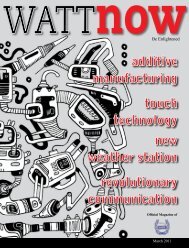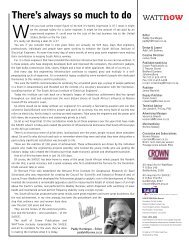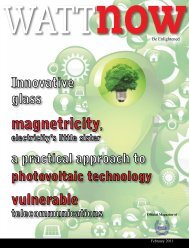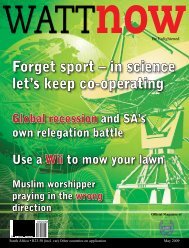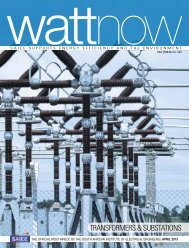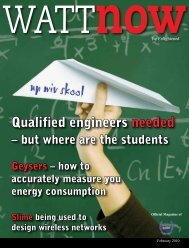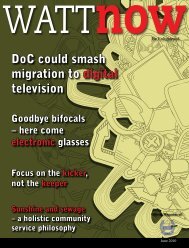download a PDF of the full September 2010 issue - Watt Now ...
download a PDF of the full September 2010 issue - Watt Now ...
download a PDF of the full September 2010 issue - Watt Now ...
- No tags were found...
Create successful ePaper yourself
Turn your PDF publications into a flip-book with our unique Google optimized e-Paper software.
What do a trunk and a fin have in common?Industrial automation specialist, Festo sets out to apply naturalprinciples to industrial practice and to use <strong>the</strong> biomechatronicresults <strong>of</strong> this process in its automation systems. This dedication isevident through <strong>the</strong> company’s Bionic Learning Network, which isan alliance <strong>of</strong> educational establishments and specialist companiestasked with exploring bionic solutions for evolutionary automationapplications.The Bionic Learning Network aims to develop decentralised, selfcontrollingand self-organising systems and its main focus is usingbionics in <strong>the</strong> formulation <strong>of</strong> new principles <strong>of</strong> operation for <strong>the</strong>delivery <strong>of</strong> energy efficient, mechanical engineering innovations.The Bionic Handling Assistant is <strong>the</strong> network’s newest <strong>of</strong>fering,providing a completely flexible and safe means <strong>of</strong> moving objects fromone position to ano<strong>the</strong>r. Inspired by an elephant’s trunk, <strong>the</strong> ‘assistant’employs innovative biomechatronics technology to minimise hazards<strong>of</strong> direct contact between machines and human operators.In <strong>the</strong> event <strong>of</strong> contact between <strong>the</strong> Bionic Handling Assistant anda human, <strong>the</strong> assistant will yield immediately without modifying itsdesired overall dynamic behaviour, and will resume its operation once<strong>the</strong> threat has been averted. Unlike o<strong>the</strong>r heavy industrial robots,this assistant is characterised by an excellent mass-payload ratio. Inaddition, it provides smooth operating motion with more degrees <strong>of</strong>freedom and makes efficient use <strong>of</strong> its resources in production andoperation.The assistant comprises three basic elements for spatial movement,along with a hand axis with ball joint and a gripper with adaptivefingers. The basic elements each comprise three circularly arrangedactuators tapering at an angle <strong>of</strong> three degrees.Each actuator is supplied with compressed air at <strong>the</strong> interfaces<strong>of</strong> <strong>the</strong> basic elements. Resetting is effected by <strong>the</strong> loop-like design<strong>of</strong> <strong>the</strong> actuators, which act like a spring when <strong>the</strong> compressed airis discharged. Bowden cable potentiometers on <strong>the</strong> outside <strong>of</strong> <strong>the</strong>actuators register <strong>the</strong>ir extension and control <strong>the</strong> system’s spatialmovement. In <strong>the</strong> hand axis, three fur<strong>the</strong>r actuators are arrangedaround a ball joint.Their activation displaces <strong>the</strong> gripper by an angle <strong>of</strong> up to 30°.SMAT sensors from Festo register <strong>the</strong> travel and make for preciseW<strong>Watt</strong>’s Technologyalignment, while VPWP proportional directional control valves areused for <strong>the</strong> overall control <strong>of</strong> <strong>the</strong> Bionic Handling Assistant.This latest innovation could open up a host <strong>of</strong> new applicationsthat involve direct, non-hazardous contact between humans androbots. These include using equipment in hospitals and rehabilitationcentres or in agricultural and animal husbandry applications.Ano<strong>the</strong>r interesting materials handling solution from Festo, is<strong>the</strong> BionicTripod 2.0, derived from <strong>the</strong> tail fin <strong>of</strong> a fish. It can bedescribed as a horizontally arranged tripod that is rotated at 90degrees from <strong>the</strong> conventional tripod configuration.It consists <strong>of</strong> a drive unit, a tripod structure free to move in allspatial directions, a flexible hand axis and an adaptive FinGrippers<strong>of</strong>t handling unit. The hand axis is structured in a way that is similarto <strong>the</strong> one used on <strong>the</strong> Bionic Handling Assistant, but has <strong>the</strong> addedadvantage <strong>of</strong> three extra degrees <strong>of</strong> freedom and a 30 degree range<strong>of</strong> deflection. The highly versatile FinGripper constitutes <strong>the</strong> interfacebetween <strong>the</strong> object and <strong>the</strong> actuators and consists <strong>of</strong> a pneumaticactuator in <strong>the</strong> form <strong>of</strong> a bellow and three gripping fingers.Precise control and displacement <strong>of</strong> <strong>the</strong> tripod structure areensured by <strong>the</strong> EGC electric linear axis and EMMS electric drivefrom Festo. The system is controlled by <strong>the</strong> CMXR robotic controls<strong>of</strong>tware, which combines mechanics, electrical drive and controltechnology into a complete kinematic systems solution and coordinateshighly dynamic spatial movements.A particular advantage <strong>of</strong> <strong>the</strong> BionicTripod 2.0’s horizontalconfiguration is that objects can be picked up from <strong>the</strong> workingsurface and deposited to <strong>the</strong> side at a different level, a beneficialfeature for different agricultural applications and for <strong>the</strong> sorting <strong>of</strong>materials for recycling. Since <strong>the</strong> structure is pliable and flexible, itis ideal for tasks in human-machine interaction and can be used insorting applications or as a ‘third’ hand.The tripod was developed to achieve a maximum scope <strong>of</strong> operationwith a minimum weight <strong>of</strong> <strong>the</strong> moving parts, which enhances energyefficiency. It is an example <strong>of</strong> <strong>the</strong> forms energy efficiency may take in<strong>the</strong> future <strong>of</strong> automation technology, made possible by electric linearactuators, electric motors, robotic control, pneumatic valves, sensortechnology and control technology from Festo.Elephant trunk: Drawing inspiration from nature, Festo mimicked <strong>the</strong>flexibility and versatility <strong>of</strong> <strong>the</strong> elephant trunk for its latest design in <strong>the</strong>Bionic Learning Network, <strong>the</strong> Bionic Handling Assistant.Bionic handling: The Bionic Handling Assistant from Festo <strong>of</strong>fers completeflexibility and <strong>the</strong> ability to safely move objects from one position to ano<strong>the</strong>r.<strong>September</strong> <strong>2010</strong> 27




